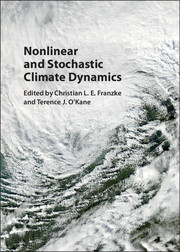Book contents
- Frontmatter
- Contents
- List of Figures
- List of Contributors
- Preface
- 1 Challenges for Ice Age Dynamics: A Dynamical Systems Perspective
- 2 Tipping Points in the Climate System
- 3 Atmospheric Teleconnection Patterns
- 4 Atmospheric Regimes: The Link between Weather and the Large-Scale Circulation
- 5 Low-Frequency Regime Transitions and Predictability of Regimes in a Barotropic Model
- 6 Complex Network Techniques for Climatological Data Analysis
- 7 On Inference and Validation of Causality Relations in Climate Teleconnections
- 8 Stochastic Climate Theory
- 9 Stochastic Subgrid Modelling for Geophysical and Three-Dimensional Turbulence
- 10 Model Error in Data Assimilation
- 11 Long-Term Memory in Climate: Detection, Extreme Events, and Significance of Trends
- 12 Fractional Stochastic Models for Heavy Tailed, and Long-Range Dependent, Fluctuations in Physical Systems
- 13 Modelling Spatial Extremes Using Max-Stable Processes
- 14 Extreme Value Analysis in Dynamical Systems: Two Case Studies
- Index
5 - Low-Frequency Regime Transitions and Predictability of Regimes in a Barotropic Model
Published online by Cambridge University Press: 26 January 2017
- Frontmatter
- Contents
- List of Figures
- List of Contributors
- Preface
- 1 Challenges for Ice Age Dynamics: A Dynamical Systems Perspective
- 2 Tipping Points in the Climate System
- 3 Atmospheric Teleconnection Patterns
- 4 Atmospheric Regimes: The Link between Weather and the Large-Scale Circulation
- 5 Low-Frequency Regime Transitions and Predictability of Regimes in a Barotropic Model
- 6 Complex Network Techniques for Climatological Data Analysis
- 7 On Inference and Validation of Causality Relations in Climate Teleconnections
- 8 Stochastic Climate Theory
- 9 Stochastic Subgrid Modelling for Geophysical and Three-Dimensional Turbulence
- 10 Model Error in Data Assimilation
- 11 Long-Term Memory in Climate: Detection, Extreme Events, and Significance of Trends
- 12 Fractional Stochastic Models for Heavy Tailed, and Long-Range Dependent, Fluctuations in Physical Systems
- 13 Modelling Spatial Extremes Using Max-Stable Processes
- 14 Extreme Value Analysis in Dynamical Systems: Two Case Studies
- Index
Summary
Abstract
The predictability of flow is examined in a barotropic vorticity model that admits lowfrequency regime transitions between zonal and dipolar states. Low-frequency regime transitions in the model were first studied by Bouchet and Simonnet (2009) and are reminiscent of regime change phenomena in the weather and climate systems wherein extreme and abrupt qualitative changes occur, seemingly randomly, after long periods of apparent stability. Mechanisms underlying regime transitions in the model are not well understood yet. From the point of view of atmospheric and oceanic dynamics, a novel aspect of the model is the lack of any source of background gradient of potential-vorticity such as topography or planetary gradient of rotation rate (e.g. as considered by Charney and DeVore, 1979).
We consider perturbations that are embedded onto the system's chaotic attractor under the full nonlinear dynamics as bred vectors – nonlinear generalizations of the leading (backward) Lyapunov vector.We find that ensemble predictions that use bred vector perturbations are more robust in terms of error-spread relationship than those that use Lyapunov vector perturbations. In particular, when bred vector perturbations are used in conjunction with a simple data assimilation scheme (nudging to truth) that estimates the current state of the system, we find that at least some of the evolved perturbations align to identify low-dimensional subspaces associated with regions of large forecast error in the control (unperturbed, data-assimilating) run; this happens less often in ensemble predictions that use Lyapunov vector perturbations. Nevertheless, in the inertial regime we consider, we find that (a) the system is more predictable when it is in the zonal regime, and that (b) the horizon of predictability is far too short compared to characteristic timescales associated with processes that lead to regime transitions, thus precluding the possibility of predicting such transitions.
Introduction
The phenomenon of blocking – large-scale patterns in the atmospheric pressure field that are nearly stationary – in the extra-tropical winter atmosphere (e.g. Charney and DeVore, 1979) is one of the best studied cases of regime transitions that occur in the weather and climate systems.
Information
- Type
- Chapter
- Information
- Nonlinear and Stochastic Climate Dynamics , pp. 136 - 158Publisher: Cambridge University PressPrint publication year: 2017
Accessibility standard: Unknown
- 1
- Cited by
